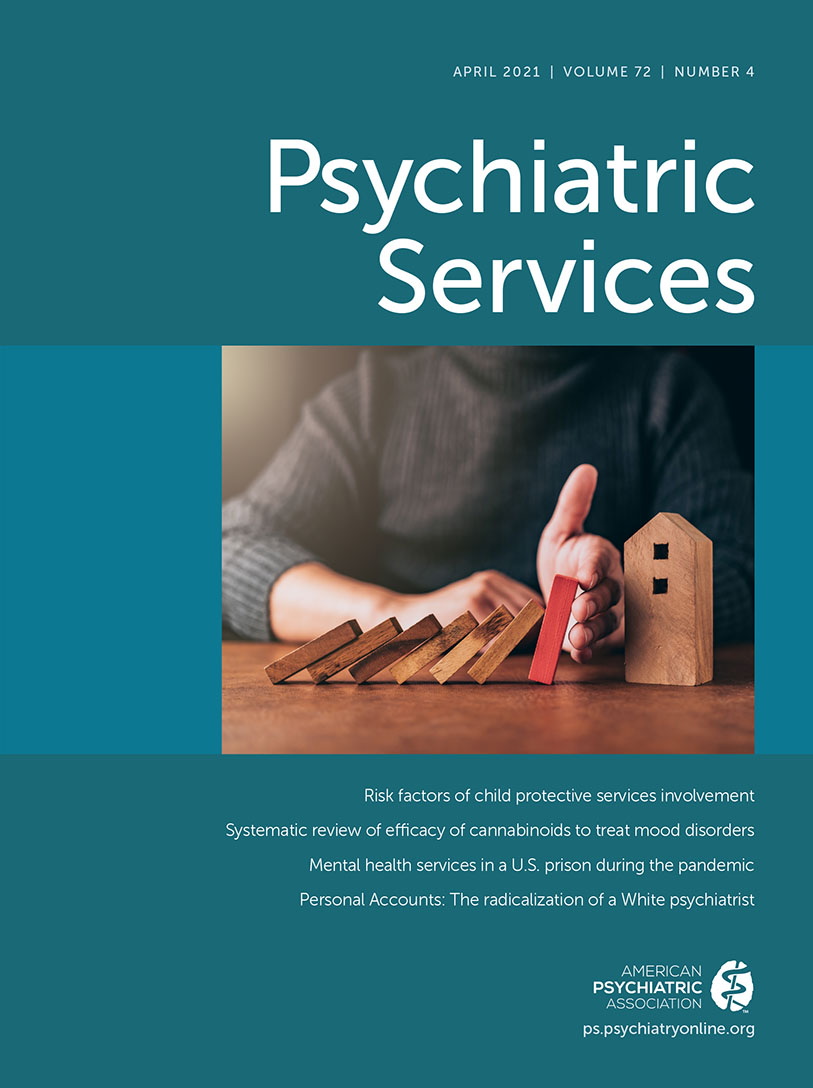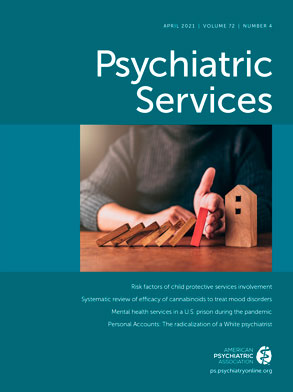Mobile health (mHealth) interventions leverage mobile devices to support patient care outside of clinical settings. mHealth strategies are emerging in all branches of health care (
1) but are particularly well suited to support mental health treatments that rely on language-based interventions that do not require medical instruments or physical contact between provider and patient (
2). mHealth has been shown to be feasible, acceptable, and helpful to people with serious mental illness (
3,
4).
As the evidence supporting the effectiveness of mobile interventions grows, it will be crucial for clinicians, system leaders, and policy makers to understand the costs associated with the integration of mHealth into practice settings. Although it is often assumed that mHealth will be cost-efficient, relatively few studies have examined this empirically (
5). Here, we report on the costs of implementing mHealth in real-world settings. Retrospective cost data were collected in the context of a randomized controlled trial comparing an evidence-based mHealth intervention to a clinic-based intervention. Both treatments were not previously in use at the agency where they were introduced.
The original mHealth study, conducted between June 2015 and September 2017, was an assessor-blind, randomized comparative effectiveness trial (
6). The study enrolled 163 participants with a mean age of 49 years; 59% of the sample were men, 65% were African Americans, and 27% were White. Among the study participants, 49% were living with schizophrenia or schizoaffective disorder, 28% with bipolar disorder, and 23% with major depressive disorder. The project was conducted in partnership with a behavioral health care agency that provides a range of community services in Chicago. A complete description of the trial and participant outcomes was published previously (
6). Individuals were randomly assigned to one of two treatments: an mHealth intervention called FOCUS or a clinic-based group intervention called Wellness Recovery Action Plan (WRAP).
FOCUS (
7,
8) is a smartphone-delivered intervention that includes technological elements (i.e., an app and online clinician dashboard) and human support, that is, an mHealth support specialist who assists participants in the technical and clinical aspects of the intervention, including initial training in how to use the app and weekly phone check-ins (
9). The FOCUS app includes preprogrammed daily self-assessments and on-demand functions that can be accessed by the user independently and 24/7. Aside from a single in-person meeting between the patient and the mHealth specialist at the start of treatment, all other FOCUS activities are done remotely via the smartphone.
WRAP is a widely used, clinic-based group intervention led by two facilitators with lived experience of mental illness (
10). Weekly sessions are 90 minutes long and involve discussions and guided activities. WRAP emphasizes equipping groups with personal wellness tools and encouraging positive thinking. Facilitators incorporate these tools into a written individual plan, which includes daily maintenance, identification of triggers and methods to avoid them, early warning signs of symptom exacerbation and response options, and a crisis management plan. Both interventions were conducted over a 3-month period for cycles of eight cohorts of participants assigned to either FOCUS or WRAP.
The interventions were delivered in parallel to individuals with similar psychiatric diagnoses and produced comparable effects, including reduction in psychiatric symptom severity, improved recovery, and high treatment satisfaction (
6). The study provided a unique opportunity to examine the costs associated with accomplishing the same clinical outcomes with the uses of substantially different treatment modalities.
Methods
The trial (conducted June 2015–September 2017 in Chicago) was approved by the institutional review boards of the University of Washington and Dartmouth College. Retrospective cost data were used to estimate, from the provider perspective, the financial costs of providing two types of treatment for people living with serious mental illness. Bottom-up microcosting is considered to be the best method to estimate clinical service costs, but collecting the needed information can be time and resource intensive. Because this cost analysis was conducted several years after the project ended, which may have made it challenging to recall the specific quantities of resources used, we used a mixed-methods approach that combined top-down expenditure analysis with microcosting to ensure that we captured all large-ticket cost items—namely, personnel time—that were used to deliver the interventions (
11,
12). These represent real-world costs that were additional to those of existing services offered during the active trial period. Program installation and training occurred from May 2015 to June 2015. We obtained actual expense data for the overall project and omitted all research-related expenditures. Costs were organized by input categories, including personnel, supplies, equipment, overhead, and indirect costs. Personnel costs—for administration, training, supervision, and clinical services—included expenses for clinical supervisors, two mental health facilitators for WRAP (50% full-time equivalent [FTE]), and a single mHealth specialist for FOCUS (30% FTE in year 1 and 50% FTE in years 2 and 3).
We used microcosting techniques to estimate personnel time and costs for FOCUS materials preparation, training, and supervision. WRAP facilitators met weekly for 45 minutes of group supervision with an expert WRAP trainer. The mHealth support specialist started with weekly 60-minute phone supervision with a clinical psychologist with expertise in the FOCUS intervention and shifted to biweekly meetings after 4 months. Supplies included materials procurement, monthly mobile phone data plan and device charges for participants in the FOCUS arm (smartphones were returned, cleaned, and repurposed at the end of each 3-month intervention cycle), general supplies, and travel reimbursements. Equipment included annualized depreciation of a mobile phone used by the mHealth support specialist in the FOCUS arm. (Indirect and overhead costs allocated to WRAP and FOCUS services are described in an online supplement to this report.) We conducted sensitivity analysis on inclusion of indirect costs, recognizing that these would vary considerably depending on the type of clinic or agency delivering the intervention and geographic location. All estimates are in unadjusted US$ for 2015 to 2017.
Results
Table 1 presents total annual and project costs by input categories for both interventions based on cost estimates for the period June 2015 to September 2017 (27 months). The total intervention cost was $175,977 for WRAP, compared with $90,989 for FOCUS. Average annual, monthly, and unit costs per client are presented in
Table 2. The average annual cost was $78,212 for WRAP and $40,439 for FOCUS. On average, WRAP cost $6,518 per month; when 10 clients were served, the cost per client per month was $652, or $1,956 for the 3-month treatment cycle. The average monthly cost for FOCUS was $3,370, or $337 per client per month and $1,011 per client for the 3-month cycle. In both interventions, labor accounted for the largest share of overall cost. Excluding indirect costs, WRAP cost $520 per client per month, compared with $256 for FOCUS.
Discussion
To our knowledge, this study is the first that has compared the costs of deploying an mHealth intervention for treatment of serious mental illness with the costs of delivering in-person group services. This study is one of only a handful of studies directly examining the costs of mHealth (
5). The study on which the cost analysis was based was uniquely suited to shed light on what it takes financially to produce comparable clinical outcomes in the same population, in the same region, over parallel treatment periods (
6). We found that FOCUS had an impact on mental health outcomes similar to that of WRAP but at approximately half the cost.
Intervention cost data were collected in the context of a research project, which often entails higher expenditures than with standard clinical deployment. In this study, higher costs for both interventions may have been linked to the costs of conducting high-fidelity trainings and ensuring ample human resourcing for ongoing clinical supervision, costs associated with device purchases, costs of personnel based at an academic institution for delivery of training and supervision, and costs of development and refinement of training tools, materials, and technology support infrastructure for the study (for both treatment groups). It is unclear whether the skills required for delivering the two interventions are commensurate. WRAP may require staff with more extensive experience and training in delivering the model, compared with staff implementing the mHealth FOCUS intervention. The interventions were deployed in a large metropolitan city where expenses for materials and staff salaries may be higher than in most other regions. Thus, the ratio of expenditures between interventions is likely to be more informative and generalizable than the specific absolute costs of each treatment, which would likely be lower if not deployed as a research study in one of the most expensive cities in the United States.
This study had several limitations. Service use was not based on individual data, and we did not include a treatment-as-usual comparator arm in the original trial. Costing was conducted after completion and publication of the previous study (
6), and we used available expense reports and microcosting techniques to capture personnel costs. Ideally, microcosting would be used to understand the quantities and prices associated with all resources used during different implementation phases, but this was not an option, given the lag after study completion. Retrospective analysis is susceptible to recall bias; therefore, we may have underestimated the time and resources used to deliver both interventions. This analysis included indirect costs associated with the clinic; however, it omitted the indirect costs associated with mHealth supervision time, because supervision was based at an academic research institution that typically has much higher indirect rates than the rates at community health clinics. It is unlikely that outside of research study contexts, academic personnel will be supervising clinical deployments of mHealth, and it is unlikely that the indirect cost exclusion changed our main finding, because when the clinic’s indirect costs were omitted (
Table 1), the cost of the mHealth intervention was still approximately half that of WRAP. Reported costs may not reflect community service needs or may not capture potential economies of scale because the caseloads were fixed at eight to 10 clients per 3-month cycle as part of the study design. In real-world care, client caseloads and therapist turnover rates may be higher than in a controlled study. Higher caseloads would drive down fixed costs, thus reducing the overall cost per client, whereas higher staff turnover would likely increase fixed costs, such as for recruitment and training.
Conclusions
The findings of this study can help inform health care payers’, providers’, and policy makers’ understanding of the utility of mobile interventions for managing serious mental illness. Results with FOCUS and other research programs (
13,
14) have demonstrated the feasibility, acceptability, and clinical promise of mHealth interventions for persons with serious mental illness. Our results provide an additional compelling argument for consideration of these innovative approaches—they can be substantially less expensive than clinic-based treatments. Notably, since the study was completed, the developers of WRAP have also created a smartphone app that guides users on development of their personal recovery plan. Whether for stand-alone recovery support technologies or for adjunctive treatment support tools, the enthusiasm for mHealth continues to grow. As mHealth interventions move from research to standard practice, we will need to develop or expand payment and reimbursement models so that they can support health care systems’ and clinicians’ ability to integrate mHealth into their clinical offerings (
15). With the current backdrop of a global pandemic that has all but halted clinic-based services on a very large scale, the need to develop more evidence-based mHealth treatment models and additional policies that support remotely administered alternatives to in-person care has never been more urgent.
Acknowledgments
The authors gratefully acknowledge the contributions of staff and members at Thresholds in Chicago and the research teams at Dartmouth College, Northwestern University, and the University of Washington, who supported all aspects of the original comparative effectiveness trial.

